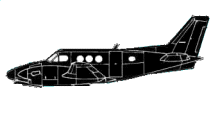
ASN Wikibase Occurrence # 154691
This information is added by users of ASN. Neither ASN nor the Flight Safety Foundation are responsible for the completeness or correctness of this information.
If you feel this information is incomplete or incorrect, you can submit corrected information.
| Date: | Friday 29 March 2013 |
| Time: | 13:00 |
| Type: |  Beechcraft C90 King Air Power90 |
| Owner/operator: | Private |
| Registration: | N90KH |
| MSN: | LJ-542 |
| Year of manufacture: | 1972 |
| Fatalities: | Fatalities: 0 / Occupants: 2 |
| Aircraft damage: | Destroyed |
| Category: | Accident |
| Location: | Sainte-Radegonde -
 France France
|
| Phase: | En route |
| Nature: | Training |
| Departure airport: | LFCS |
| LFBE | |
| Investigating agency: | BEA |
| Confidence Rating: |
The pilot and two passengers took off under an IFR flight plan from Sarlat-Domme aerodrome for a training flight in the Bordeaux region. The pilot carried out a precision approach followed by a go-around at Bordeaux-Mérignac. It closed its IFR flight plan and continued its VFR flight towards Bordeaux-Léognan-Saucats aerodrome where it landed. He dropped off one of the passengers without stopping the engines then took off again a few minutes later for Bergerac where he planned to refuel. After ten minutes of flight, at an altitude of about 2000 ft, the two engines stopped. The pilot made a forced landing facing southwest.
The N90KH is equipped with two General Electric-Walter GE M601E-11 turboprop engines.
conclusions:
- The pilot took off with about 800 pounds of fuel, expecting to have an hour and a half of autonomy, ie the autonomy available with 800 liters.
- Under these conditions, he had neither the sufficient quantity of fuel to carry out this flight nor the reserves required for a flight in IFR mode.
- The stopping of the engines due to lack of fuel and the resulting forced landing are therefore probably due to a confusion between the units of measurement (Liters and Pounds).
- The lack of a visual check of the quantity of fuel before the flight departure did not allow the pilot to notice his error.
- The safety principle consisting in the pilot checking the quantity present on board from different sources, makes it possible to limit the risk of running out of fuel.
Accident investigation:
 |
|
Sources:
http://www.bea.aero/fr/enquetes/2013/2013.semaine.13.pdf
https://www.sudouest.fr/2013/03/30/un-avion-atterrit-dans-les-vignes-1009823-2251.php (french only)
picture of the aircraft in better times : http://www.airliners.net/photo/Beech-C90-King/1381407/L?sid=fc6e8c9bd6a7be9b91581706ca484ac8
USCAR
AL 561
Revision history:
| Date/time | Contributor | Updates |
|---|---|---|
| 31-Mar-2013 11:31 | simulator | Added |
| 03-Apr-2013 11:12 | werewolf | Updated |
| 03-Apr-2013 17:13 | harro | Updated [Source, Narrative] |
| 28-Jan-2014 19:08 | wf | Updated [Source, Damage, Narrative] |
| 20-May-2021 19:09 | harro | Updated [Aircraft type, Operator, Phase, Nature, Narrative, Accident report] |
Corrections or additions? ... Edit this accident description
The Aviation Safety Network is an exclusive service provided by:


 ©2024 Flight Safety Foundation
©2024 Flight Safety Foundation